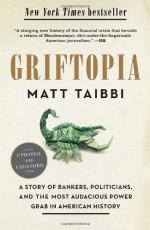
|
| Name: _________________________ | Period: ___________________ |
This test consists of 5 multiple choice questions, 5 short answer questions, and 10 short essay questions.
Multiple Choice Questions
1. According to the author, the top one percent of Americans own almost what percent of the wealth?
(a) 40.
(b) 30.
(c) 60.
(d) 20.
2. What is a private, actively managed investment fund that utilizes sophisticated strategies in international and/or domestic markets, offsets losses during a market downturn, and/or generates returns higher than traditional stock and bond investments?
(a) Derivatives fund.
(b) Hedge fund.
(c) Credit fund.
(d) Stock portfolio.
3. In Chapter 3, what process in which loans are split up and sold off to secondary investors as securities was used by banks?
(a) Authorization.
(b) Securitization.
(c) Amortization.
(d) Derivatives.
4. When was Atlas Shrugged published?
(a) 1948.
(b) 1957.
(c) 1940.
(d) 1968.
5. Alan Greenspan was born in what area of New York City?
(a) The Upper East Side.
(b) Greenwich Village.
(c) Washington Heights.
(d) Astoria, Queens.
Short Answer Questions
1. For what political party was Sarah Palin the nominee for Vice President of the United States?
2. What involves an exchange of the defaulted loan instrument (and with it the right to recover the default loan at some later time) for immediate money - usually the face value of the loan?
3. Who is the protagonist of Atlas Shrugged?
4. According to the author, what philosophy translates to "My facts are facts and your facts are not facts"?
5. During his economic studies, Alan Greenspan worked under Eugene Banks, a managing director at what Wall Street investment bank?
Short Essay Questions
1. What actions did Alan Greenspan take which led directly to the housing bubble bust?
2. How did Matt Taibbi feel about the Presidential campaign in Chapter 1? What events were unforeseen at this point in history?
3. How are "no doc" loans described in Chapter 3? How were the borrowers scammed in this system?
4. What impact did Alan Greenspan have on the Federal Reserve during his years in power?
5. Describe Alan Greenspan's childhood and education. Where did Greenspan study economics?
6. Who was Eljon Williams and how did he become involved in a mortgage scam as described in Chapter 3?
7. What does Taibbi assert to be the fundamental problem the the Tea Party's approach?
8. What does Taibbi write of his thoughts on Sarah Palin in Chapter 1?
9. How did the public and private sectors evolve and change during Alan Greenspan's reign of the Federal Reserve, as described in Chapter 2?
10. How does the Tea Party mislead its followers from the true enemy, according to the author?
|
This section contains 949 words (approx. 4 pages at 300 words per page) |

|




